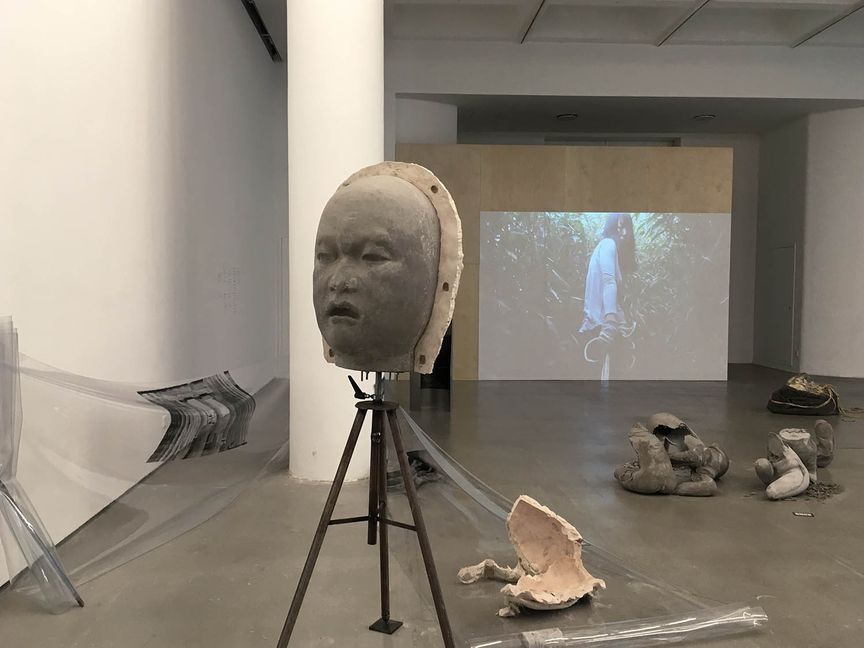YU JI’s presentation was on the museum’s second floor. Yu’s practice is focused on the peculiarities of material and process—in particular, resin, beeswax and concrete have constantly reappeared in her renditions of the body, which often quote details from Greco-Roman sculptures. The video in the back documents the artist lugging a rock up a hill on the east coast of Taiwan.
The heaviness of the entangled iron chains which comprise YU JI’s Etudes-Lento IV (2017) was further dramatized by the resin skins in which the metal was encased. Over the course of the day, the resin very slowly drips down onto the plastic sheets below. Printed on these transparent screens were images of various architectural elements, including an arched window.
On the third floor, visitors sat at individual, futuristic-looking booths to watch the nine channels that make up TAO HUI’s Hello, Finale! (2017). The gray slabs that frame the monitors are meant to evoke gravestones—while each of the videos present unique storylines, what unites them in theme is death. The artist drew from various headline cases of people’s passing and couched these in a style of cinematography typically found in Japanese TV-dramas, blurring fiction and non-fiction.
TAO HUI chose to add a clinical tint to the light in his section by adding blue filters to the windows. The sharp, artificial blue was echoed in the framed footage of The Acting Tutorial (2014), in which we watch actors rehearsing for a performance, adding a reflexive layer that comments on the construction behind the images that we consume.
Blue also acts as the backdrop to TAO HUI’s The Dusk of Tehran (2014), based on the life of Cantonese pop icon Anita Mui. In the video, an Iranian actress reenacts one of Mui’s conversations with her fans, during which she explains the pressures that she faces as a woman to get married and have children, and how this is conflictive with the pressures she faces in her career as an actress and singer. The work draws parallels with the social realities encountered by women around the world.
Under the fictive banner of the Institute of Critical Zoologists, ROBERT ZHAO RENHUI examines the intersections between the nation-state and ecology, history and fiction. His presentation on the fourth floor began with photographic documentation of 4,784 specimens of the hoverfly, each accompanied with unique tags displaying the geographical coordinates where the samples were found. Entomologist Martin Hauser, who works for the California Department of Food and Agriculture, collected the flies—Hauser is responsible for guarding the Californian borders against potentially invasive insects hiding in imported crops.
ROBERT ZHAO RENHUI also drew from Walter William Skeat’s Malay Magic, published in 1900 as a guide to the folklore practiced in the Malay Peninsula. The book describes a setup used by Malay hunters to trap pigeons for food, which entailed a trained pigeon luring a wild pigeon to a hunter, who would capture the bird with a hooped rod. Zhao demonstrated the trap with an almost comical staging of objects.
Turning the corner from ROBERT ZHAO RENHUI’s densely packed cabinets of curiosities, visitors were confronted with the stark-white installation Eskimo Wolf Trap Often Quoted in Sermons (2013), which features a single bloodied blade protruding from a blanket of fake snow.
Zhao’s labyrinthine presentation layout was escalated by LI MING in his showcase one floor above. Li demarcated his allotted space with a series of dark, twisting corridors, in which his video work Rendering the Mind (2017) was laid out across several screens in a horizontal line, evoking the hallways of the historic Shanghai hotel, Broadway Mansions. The silhouette of the hotel can be seen here.
The meandering path that visitors had to navigate through the artist’s presentation was echoed in LI MING’s own performances, which he documented via video. The artist often uses his own body to explore spatial and societal relations through the simple gesture of walking—often with no destination.
Utilizing the museum’s original structure, visitors were further guided to circumambulate around LI MING’s central videos, shot from various locations in Shanghai. The iconic, bulbous Oriental Pearl Tower drove the circular motif home, while other hanging monitors showed nondescript buildings. Playing with scale and perceptions, the artist would rapidly zoom in on details of the structures.





